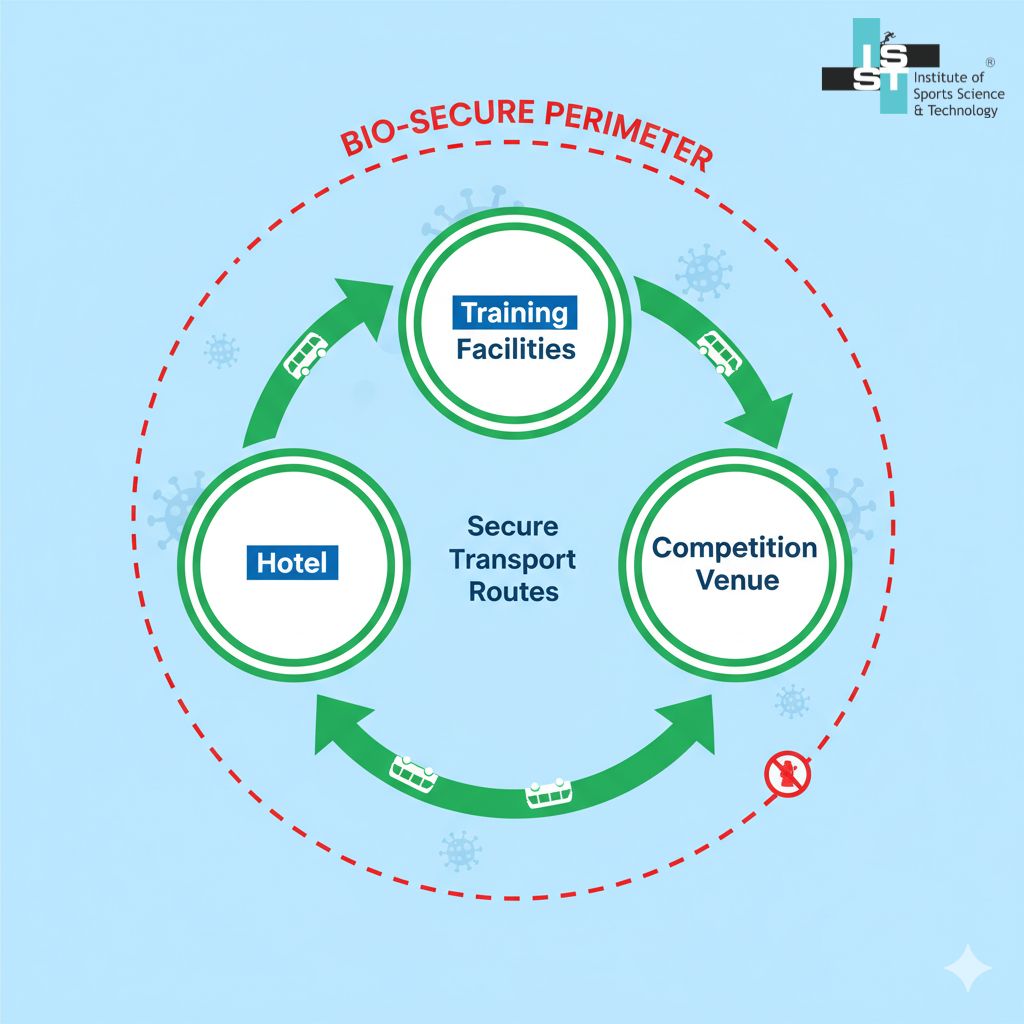Cast your mind back to 2020. The world stopped, stadiums fell silent, and the roar of the crowd was replaced by an unnerving quiet. For a moment, it seemed like live professional sports—a global multi-billion dollar industry—was simply over.
And then, a new term entered our vocabulary: bio-bubble.
It was the solution that allowed the NBA, IPL, Formula 1, and countless other leagues to restart. It was a lifeline that saved seasons, careers, and broadcasting contracts. But understanding what is a bio bubble goes far beyond a simple definition. It was one of the most complex logistical, psychological, and financial experiments in the history of sports.
For sports fans, it was a way to get the game back. But for a sports management professional, it was a masterclass in crisis management, operations, and human resources. This article explores the bio-bubble not just as a definition, but as a critical case study for the future of the sports industry.
So, What is a Bio Bubble in Practical Terms?
At its simplest, a bio-bubble (or “bio-secure environment”) is a sanitized, access-controlled “safe zone” designed to protect a group of people from a contagious disease—in this case, COVID-19.
Think of it as a fortress. Once inside, individuals are completely isolated from the outside world. Nobody gets in, and nobody gets out (without strict quarantine protocols). The goal is to create a sterile environment where the virus cannot enter, allowing athletes to train, compete, and live without risk of infection.
But creating this fortress wasn’t as simple as just booking a hotel. It involved an intricate web of protocols.
The Core Components of a Bio-Secure Environment
To function, a bio-bubble relied on several non-negotiable pillars:
- 1. Restricted Access & Zones: The “bubble” itself was a designated area, often including hotels, training facilities, and the competition venue. Only pre-approved individuals (athletes, coaches, medical staff, broadcasters, essential personnel) were allowed in.
- 2. Rigorous Testing: This was the bubble’s immune system. Individuals were often tested daily. A single positive test would trigger immediate isolation and contact tracing to prevent an outbreak.
- 3. Strict Quarantine: Before even entering the bubble, every individual had to undergo a mandatory quarantine period (e.g., 7-14 days) and return multiple negative tests.
- 4. Controlled Transportation: All travel, whether from the hotel to the stadium or between cities (in the case of F1 or some cricket tours), was done via private, sanitized transportation.
- 5. Zero Contact with the Outside: This was the most challenging rule. No family, no friends, no delivery food, no public interaction. The bubble was a self-contained universe.

Why Was the Bio-Bubble Necessary?
The sports industry didn’t create bio-bubbles just to keep fans entertained. The decision was driven by two core factors: financial survival and competitive integrity.
The Financial Imperative
The modern sports industry runs on two main engines: broadcasting rights and sponsorships.
In 2020, leagues were faced with a catastrophic choice: cancel their seasons and breach multi-billion dollar television contracts, or find a way to play. The financial implications of cancellation were staggering, threatening the existence of smaller clubs and the salaries of thousands of employees.
The bio-bubble was the multi-million dollar gamble leagues took to protect their billion-dollar revenue streams. By getting “the product” back on TV, they could fulfill their contractual obligations, even without ticket-buying fans.
Maintaining Competitive Integrity
How do you crown a champion if half the season is cancelled? How can you relegate or promote teams? For a league to be considered legitimate, the competition must be completed. The bubble was the only way to provide a safe and level playing field for all teams to finish their seasons.
Case Studies in Bubble-Nomics: Two Giants, Two Strategies
Not all bio-bubbles were created equal. The strategy and execution varied wildly, offering incredible lessons in event management and logistics. Let’s compare two of the largest.
The Gold Standard: The NBA “Bubble” at Disney World
Many consider the NBA’s 2020 bubble in Orlando, Florida, to be the “gold standard” of bio-secure environments.
- The Setup: The NBA took over a significant portion of the Walt Disney World resort. They housed 22 teams in three separate hotels, built state-of-the-art practice facilities, and used a single arena complex for all games.
- The Cost: It was a monumental undertaking, reportedly costing the league over $150 million.
- The Result: It was a resounding success. For over three months, the NBA reported zero positive COVID-19 cases among its players inside the bubble. They successfully completed their season and crowned a champion.
- The Key Lesson: A single, controllable, self-contained site was the most effective (though most expensive) way to ensure biosecurity.
The Logistical Giant: The Indian Premier League (IPL) Bubble
The IPL, cricket’s most lucrative league, faced a different challenge. It couldn’t relocate to a single campus.
- The 2020 Setup (UAE): The IPL moved its entire tournament to the United Arab Emirates (UAE), using three stadiums across three cities (Dubai, Abu Dhabi, and Sharjah). This created multiple bubbles, with teams traveling between them in secure convoys.
- The 2021 Setup (India): The league attempted to replicate this multi-city bubble model back in India. However, the travel between cities during a severe wave of the pandemic proved to be its weak point. The bubble was breached, several players tested positive, and the tournament was abruptly suspended.
- The Key Lesson: The complexity—and risk—of a bio-bubble increases exponentially with each new location and every instance of travel. It demonstrated the immense difficulty of managing biosecurity outside of a single “campus” environment.

The Unseen Side of the Bubble: The Human Element
While the logistics were a marvel, the bio-bubble came at a significant human cost. This is where “athlete management” took on a whole new meaning.
For weeks and sometimes months, players and staff were isolated from their families, confined to their hotel rooms and the sports venue.
“Bubble Fatigue” and the Mental Health Crisis
A new term quickly emerged: “bubble fatigue.” Athletes, who are used to the routine of travel and the energy of a crowd, were now living in a sterile, repetitive environment.
- Isolation and Loneliness: Many players spoke out about the intense psychological toll. England cricketer Ben Stokes, for example, took a break from the game, citing the cumulative effect of bubble life and personal tragedy.
- Performance Impact: Athletes were expected to perform at an elite level while struggling with their mental health. There was no “escape” from the game. Your hotel room, your dining hall, and your workplace were all in the same compound.
- The Strain on Staff: It wasn’t just the star players. Coaches, medical teams, chefs, and operational staff were also trapped, working grueling hours away from their loved ones.
The bio-bubble era forced a global conversation about athlete welfare. It proved that a sports organization’s responsibility isn’t just physical safety; it’s also psychological safety.
What is a Bio-Bubble’s Legacy in Sports Management?
The bio-bubble itself may be a thing of the past, but its impact on the sports industry is permanent. For anyone studying sports management, the bubble is one of the most important case studies of our time.
It taught us three critical lessons:
- A New Playbook for Crisis Management: The bio-bubble proved that the sports industry can adapt and innovate at lightning speed. It created a new playbook for health, safety, and operational continuity that will be used for decades.
- The Rise of Athlete Welfare: Post-2020, no serious sports organization can treat mental health as an afterthought. The bubble exposed the vulnerability of athletes and forced leagues to invest heavily in psychological support, mental health officers, and more humane scheduling.
- The Power of Logistics: The bubble was a triumph of event logistics. It required collaboration between experts in health, security, travel, hospitality, and communications. It showed that the most valuable people in a sports organization aren’t always the ones on the field.
Training the Next Generation of Sports Leaders at ISST Pune
When you ask what is a bio bubble, the simple answer is “a secure zone.” But the real answer is that it was a complex intersection of financial management, event operations, human resources, and crisis communications.
This is precisely what we train our students to handle at ISST Pune.
The bio-bubble is a perfect example of the challenges modern sports managers face. Our curriculum isn’t just about the rules of the game or marketing a team. It’s about a 360-degree understanding of the business.
- Our [internal link: Sports Management Courses] dive deep into operational logistics, risk assessment, and financial planning—the very skills needed to pull off a bio-bubble.
- We analyze real-world case studies, from the NBA’s success to the IPL’s challenges, to understand what works and what doesn’t.
- We emphasize athlete welfare and the “human side” of sports, preparing our students to be empathetic leaders who can manage the well-being of their teams, not just their performance.
The sports leaders of tomorrow are the ones who can handle the next “bio-bubble”—whatever form it may take. They are problem-solvers who understand that sports management is about managing people, assets, and crises, all at once.
Conclusion: Beyond the Bubble
The bio-bubble was a remarkable, temporary fix to an unprecedented global problem. It saved professional sports from financial ruin and gave fans a much-needed sense of normalcy in a chaotic world.
But its true legacy is the lesson it taught us. It revealed the incredible complexity of the modern sports machine and highlighted the critical importance of operations, logistics, and human empathy.
Understanding what is a bio bubble is no longer a trivial pursuit. It’s a key to understanding the resilience, adaptability, and fragility of the global sports industry. It’s the difference between being a spectator and being a leader.
Are you ready to be a leader?
Your Journey in Sports Management Starts Here
Don’t just watch sports history—learn how to make it. If you’re ready to build a career managing the complex and exciting world of professional sports, ISST Pune is where you start.
Explore ISST Pune’s industry-leading Sports Management programs today and become a leader of tomorrow!




